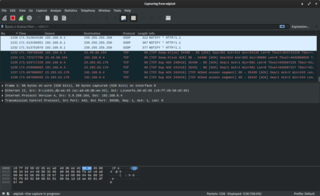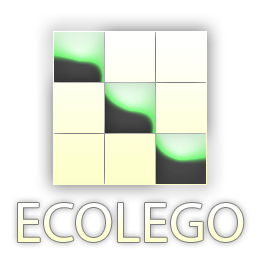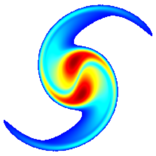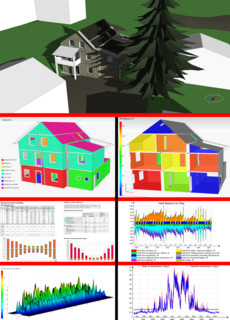Related Research Articles

LS-DYNA is an advanced general-purpose multiphysics simulation software package developed by the former Livermore Software Technology Corporation (LSTC), which was acquired by Ansys in 2019. While the package continues to contain more and more possibilities for the calculation of many complex, real world problems, its origins and core-competency lie in highly nonlinear transient dynamic finite element analysis (FEA) using explicit time integration. LS-DYNA is used by the automobile, aerospace, construction and civil engineering, military, manufacturing, and bioengineering industries.
Fuzzing or fuzz testing is an automated software testing technique that involves providing invalid, unexpected, or random data as inputs to a computer program. The program is then monitored for exceptions such as crashes, failing built-in code assertions, or potential memory leaks. Typically, fuzzers are used to test programs that take structured inputs. This structure is specified, e.g., in a file format or protocol and distinguishes valid from invalid input. An effective fuzzer generates semi-valid inputs that are "valid enough" in that they are not directly rejected by the parser, but do create unexpected behaviors deeper in the program and are "invalid enough" to expose corner cases that have not been properly dealt with.
In software engineering, behavior-driven development (BDD) is an Agile software development process that encourages collaboration among developers, QA and non-technical or business participants in a software project. It encourages teams to use conversation and concrete examples to formalize a shared understanding of how the application should behave. It emerged from test-driven development (TDD). Behavior-driven development combines the general techniques and principles of TDD with ideas from domain-driven design and object-oriented analysis and design to provide software development and management teams with shared tools and a shared process to collaborate on software development.

A crash simulation is a virtual recreation of a destructive crash test of a car or a highway guard rail system using a computer simulation in order to examine the level of safety of the car and its occupants. Crash simulations are used by automakers during computer-aided engineering (CAE) analysis for crashworthiness in the computer-aided design (CAD) process of modelling new cars. During a crash simulation, the kinetic energy, or energy of motion, that a vehicle has before the impact is transformed into deformation energy, mostly by plastic deformation (plasticity) of the car body material, at the end of the impact.

Wireshark is a free and open-source packet analyzer. It is used for network troubleshooting, analysis, software and communications protocol development, and education. Originally named Ethereal, the project was renamed Wireshark in May 2006 due to trademark issues.
In software engineering, graphical user interface testing is the process of testing a product's graphical user interface to ensure it meets its specifications. This is normally done through the use of a variety of test cases.
Code_Saturne is a general-purpose computational fluid dynamics free computer software package. Developed since 1997 at Électricité de France R&D, Code_Saturne is distributed under the GNU GPL licence. It is based on a co-located finite-volume approach that accepts meshes with any type of cell and any type of grid structure.
Fire Dynamics Simulator (FDS) is a computational fluid dynamics (CFD) model of fire-driven fluid flow. The computer program solves numerically a large eddy simulation form of the Navier–Stokes equations appropriate for low-speed, thermally-driven flow, with an emphasis on smoke and heat transport from fires, to describe the evolution of fire.

SimulationX is a CAE software application running on Microsoft Windows for the physical simulation of technical systems developed and sold by ESI ITI GmbH in Dresden, Germany.
OptiY is a design environment providing modern optimization strategies and state of the art probabilistic algorithms for uncertainty, reliability, robustness, sensitivity analysis, data-mining and meta-modeling.
Quantemol Ltd is based in University College London initiated by Professor Jonathan Tennyson FRS and Dr. Daniel Brown in 2004. The company initially developed a unique software tool, Quantemol-N, which provides full accessibility to the highly sophisticated UK molecular R-matrix codes, used to model electron polyatomic molecule interactions. Since then Quantemol has widened to further types of simulation, with plasmas and industrial plasma tools, in Quantemol-VT in 2013 and launched in 2016 a sustainable database Quantemol-DB, representing the chemical and radiative transport properties of a wide range of plasmas.

Ecolego is a simulation software tool that is used for creating dynamic models and performing deterministic and probabilistic simulations. It is also used for conducting risk assessments of complex dynamic systems evolving over time.
The JAUS Tool Set (JTS) is a software engineering tool for the design of software services used in a distributed computing environment. JTS provides a Graphical User Interface (GUI) and supporting tools for the rapid design, documentation, and implementation of service interfaces that adhere to the Society of Automotive Engineers' standard AS5684A, the JAUS Service Interface Design Language (JSIDL). JTS is designed to support the modeling, analysis, implementation, and testing of the protocol for an entire distributed system.
Pam-Crash is a software package from ESI Group used for crash simulation and the design of occupant safety systems, primarily in the automotive industry. The software enables automotive engineers to simulate the performance of a proposed vehicle design and evaluate the potential for injury to occupants in multiple crash scenarios.

Simcenter Amesim is a commercial simulation software for the modeling and analysis of multi-domain systems. It is part of systems engineering domain and falls into the mechatronic engineering field.

Gerris is computer software in the field of computational fluid dynamics (CFD). Gerris was released as free and open-source software, subject to the requirements of the GNU General Public License (GPL), version 2 or any later.

Building performance simulation (BPS) is the replication of aspects of building performance using a computer-based, mathematical model created on the basis of fundamental physical principles and sound engineering practice. The objective of building performance simulation is the quantification of aspects of building performance which are relevant to the design, construction, operation and control of buildings. Building performance simulation has various sub-domains; most prominent are thermal simulation, lighting simulation, acoustical simulation and air flow simulation. Most building performance simulation is based on the use of bespoke simulation software. Building performance simulation itself is a field within the wider realm of scientific computing.
Sensitivity analysis identifies how uncertainties in input parameters affect impotrant measures of building performance, such as cost, indoor thermal comfort, or CO2 emissions. Input parameters for buildings fall into roughly three categories:

IDA IndoorClimate andEnergy is a Building performance simulation (BPS) software. IDA ICE is a simulation application for the multi-zonal and dynamic study of indoor climate phenomenas as well as energy use. The implemented models are state of the art, many studies show that simulation results and measured data compare well.
References
- 1 2 Schmitt, K-U; Niederer, PF; Muser, MH; Walz, F (2007). Trauma biomechanics: accidental injury in traffic and sports (2nd ed.). Berlin: Springer-Verlag. ISBN 978-3-540-73872-5.
- ↑ "MADYMO Reference Manual".
- ↑ "MADYMO Solver".
- ↑ "MADYMO dummy models".
- ↑ "MADYMO Human models".
- ↑ "Testimonials".
- ↑ "AORC benchmark".